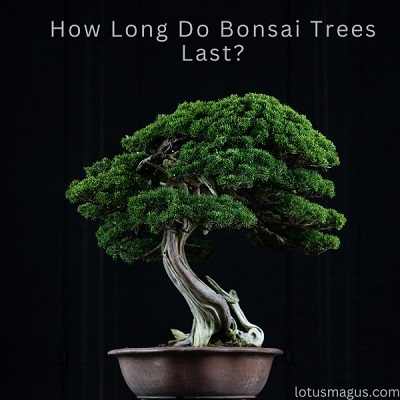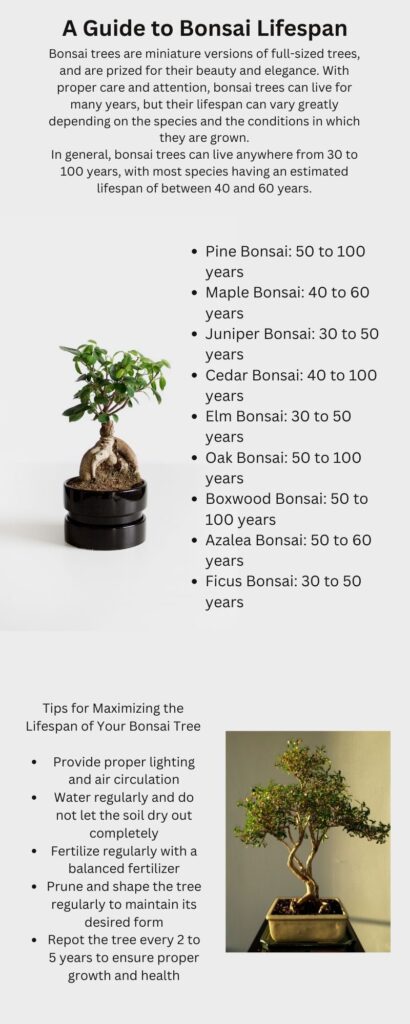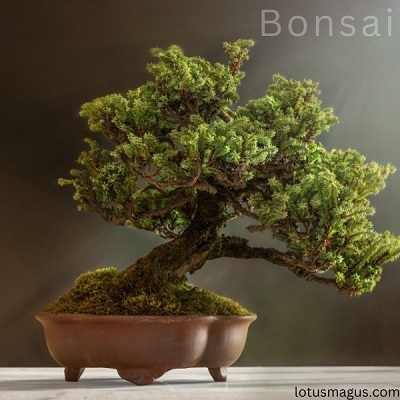People of different backgrounds have appreciated bonsai trees for generations. But have you ever wondered How Long Do Bonsai Trees Last? We’ll discuss bonsai trees’ lifespan, maintenance, and why they live so long in this post.
How Long Do Bonsai Trees Live?
Bonsai trees may live over 100 years under the appropriate circumstances such as owner care, Water and frequently pruning of bonsai. This keeps them alive and protected from harsh temperatures and conditions. Some bonsai species survive longer than others if cared appropriately such as Chinese elms and Japanese white pines may live up to 200 years. Some kinds, like the Japanese maple and Japanese black pine, may live up to a thousand years.
Ficus bonsai trees may survive for centuries. These trees may live for 10 years or more with careful care, making them a long-term bonsai addition.
As gardeners, we marvel at nature’s stunning creations. Bonsai illustrates this. The precision and care used to grow these little trees yields astounding results. The oldest bonsai tree is nearly 1000 years old.
For the oldest bonsai tree, care and attention determine its age. For over 1,000 years, this tree has been clipped and managed, enabling it to survive longer than its full-size rivals. Due to continual care, bonsai plants live 25% longer.
The oldest bonsai tree is a magnificent example of horticultural expertise and perseverance. It celebrates bonsai skill and nature’s beauty.
If properly cared for, Ficus bonsai trees may thrive for a long time. If properly cared for, a ficus bonsai tree may last at least 10 years. However, ficus bonsai trees have lived for 100 years or more, proving their durability.
Care for your ficus bonsai to extend its longevity. This involves giving the tree enough light, water, and nutrients and trimming and shaping it to preserve its form and size. Extreme temperatures, pests, and illnesses may also harm your ficus bonsai.

| Type of Bonsai Tree | Estimated Lifespan |
|---|---|
| Pine Bonsai | 50 to 100 years |
| Maple Bonsai | 40 to 60 years |
| Juniper Bonsai | 30 to 50 years |
| Cedar Bonsai | 40 to 100 years |
| Elm Bonsai | 30 to 50 years |
| Oak Bonsai | 50 to 100 years |
| Boxwood Bonsai | 50 to 100 years |
| Azalea Bonsai | 50 to 60 years |
| Ficus Bonsai | 30 to 50 years |
Download the bonsai tree lifespan chart:

How long do bonsai trees last indoors?
The species, habitat, and maintenance of an indoor bonsai tree determine its longevity. With careful care, many bonsai plants may thrive for decades inside. Depending on species and circumstances, bonsai trees may live from a few years to several hundred. A Ficus bonsai tree may last at least 10 years, but certain Pine species can live 50 to 100 years. Indoor bonsai trees need sufficient light, water, fertilizers, and environmental protection to live long.
Indoor bonsai trees need care to survive. Light, water, nutrients, and environmental protection are needed. For best development and health, place the bonsai tree near a south-facing window. To keep the plant healthy and growing, give it ample light. To promote the bonsai tree’s development and health, it’s crucial to check soil moisture and regulate watering, and to offer the right sort and quantity of fertilizer.
The species, habitat, and maintenance of a potted bonsai tree determine its longevity. Bonsai trees may survive decades or centuries with appropriate care. Bonsai trees may survive for hundreds or even thousands of years. A bonsai tree might perish if not cared for. A potted bonsai tree needs light, water, fertilizers, protection from environmental stresses, and regular trimming and care to live the longest.
| Specification | Description |
|---|---|
| Plant | Bonsai Tree (Various species) |
| Lifespan | Can live over 100 years under appropriate circumstances |
| Factors Affecting Lifespan | Owner care, water, pruning, protection from harsh temperatures and conditions |
| Species Lifespan | Different species have different lifespans depending on how well they are cared for |
| Examples | Chinese elms and Japanese white pines can live up to 200 years, while Japanese maple and Japanese black pine can live up to a thousand years |
| Environment | Bonsai trees can be grown indoors or outdoors, depending on the species and climate |
| Appearance | Miniature tree with a unique shape, size, and color |
| Light Requirements | Varies depending on the species |
| Water Requirements | Varies depending on the species, but generally requires regular watering with well-draining soil |
| Soil Requirements | Varies depending on the species, but generally requires well-draining soil with appropriate nutrients |
| Maintenance | Requires regular pruning, watering, fertilization, and repotting as necessary to maintain health and shape |
How long do bonsai trees take to grow from seed?
Bonsai plants need patience. Growing a bonsai from seed or seedling takes five to ten years. Bonsai growth requires stunting.
Limiting bonsai growth stunts its size and form. Pruning, root maintenance, and strategic wiring form the branches and trunk. These methods keep the tree small and shape it.
The bonsai needs light, water, and fertilizer. It’s crucial to monitor and adapt the tree’s surroundings. Bonsai trees are fragile and need certain conditions to grow.
What is the oldest bonsai tree alive?

The oldest bonsai tree living is apparently a Ficus Bonsai tree at the Italian Bonsai museum “Crespi” in Italy, which is estimated to be over a 1000 years old. This bonsai tree is regarded the oldest in the world and is the primary tree on show at the museum.
Peace and friendship are symbolized by the 500-year-old Meijijingu Gaien Japanese White Pine. It has been on display at Tokyo’s Meiji Shrine since 1915. One of Japan’s most famous bonsai trees.
Saitama’s Omiya Bonsai Museum contains the 400-year-old Museum Tree. This bonsai tree is notable for its delicate branches and leaves. This museum favorite exhibits bonsai’s beauty and longevity.
These bonsai trees are ancient. Each is a beautiful bonsai and a tribute to its caretakers. They show our ingenuity and nature’s might. Peace and friendship are symbolized by the 500-year-old Japanese white pine. Since 1915, it has been on exhibit at Tokyo’s Meiji Shrine. One of Japan’s most renowned bonsai trees, it is gorgeous.
In Saitama, Japan’s Omiya Bonsai Museum, the Museum Tree is nearly 400 years old. This bonsai tree’s delicate branches and leaves create a harmonious design. It showcases bonsai’s beauty and longevity and is a museum favorite.
Some of the world’s oldest bonsai trees are these. Each one is a wonderful bonsai and a sign of its carers’ love and commitment. They show nature’s strength and humans’ capacity to transform it into art.
Bonsai Species with a Long Lifespan
These trees have different lifespans and growth needs. e.g.
Cedar trees live thousands of years.
The cypress tree can survive for hundreds of years, and its strong wood is great for furniture, construction, and outdoor projects.
Pine trees grow tall and have a long lifespan.
Evergreen ficus trees can live 50–100 years.
Maples are great for little yards and can survive for 300 years if cared for.
Azaleas are 15-25-year-old trees with stunning flowers and foliage.
Finally, the cherry tree, with a 25-50-year lifespan and tasty fruit, is a good garden choice.
Why are bonsai trees so hard to keep alive?
Bonsai trees grow in tiny pots, making it hard to provide them adequate water, nutrients, and room. A bonsai tree needs frequent watering, fertilization, sunshine, humidity, and temperature to be healthy. To keep the tree in shape, utilize correct trimming, wiring, and styling.
Bonsai demands constant care and attention, which makes it tough to maintain. Bonsai trees require more water and fertilizer than regular houseplants since they are cultivated in tiny pots with limited soil and root area. To preserve form, bonsai trees must be trimmed and wired periodically.
Bonsai is challenging since it takes years for a tree to acquire its ideal shape and size, and much longer to grow into its complete form. This may discourage gardeners seeking fast pleasure.
Bonsai trees need maintenance like any other living thing. A bonsai tree may be a beautiful and satisfying addition to any house or garden with appropriate care.
How much is a 400 year old bonsai tree worth?
A 400-year-old bonsai tree’s worth depends on its species, size, age, rarity, condition, and bonsai master’s reputation.
The 400-year-old shimpaku juniper bonsai tree was worth over $120,000. However, bonsai tree prices vary widely depending on market circumstances and region. The buyer’s willingness to pay determines a bonsai tree’s worth. Bonsai trees are prized for their beauty, artistry, and methods.
How long does it take for a bonsai tree to grow to full size?
Depending on the species, bonsai trees take years to grow to full size. Bonsai trees are taught to remain tiny, so they develop slowly. A bonsai tree may attain its full size and potential in 5–10 years. How long a bonsai tree takes to grow depends on its age when acquired. If the bonsai tree is bigger and more mature when acquired, it will normally grow faster. Regular pruning, trimming, and shaping may keep bonsai trees small for years.
5 ways to Increase lifespan of bonsai tree
Gardeners everywhere have admired bonsai for ages. Bonsai trees, smaller copies of bigger trees, may enhance any house or garden. However, without adequate care, many bonsai plants may soon wilt and die. Five strategies to maintain a bonsai tree alive and healthy:
Adequate Lighting: Bonsai plants need plenty of natural light. Your bonsai tree needs 4–6 hours of direct sunshine daily. Use a grow lamp to simulate sunshine inside.
Specialized Soil: Bonsai plants need specialized soil. This lightweight, well-draining soil minimizes root rot. Avoid regular potting soil.
Watering appropriately : Bonsai plants require regular watering to be healthy. Water your bonsai tree once or twice a week, depending on its kind and location. Water your tree thoroughly so the earth can absorb it. Overwatering or underwatering may kill a tree.
Fertilizer: Your bonsai tree needs regular fertilization to thrive. Follow the directions on a bonsai fertilizer. Since trees develop most in spring and summer, fertilization is crucial.
Pruning: Bonsai tree health depends on pruning. It enhances flower and fruit development, healthy growth, and fullness. Only prune dead or diseased branches using sharp shears. Bonsai trees benefit from regular trimming.
These five measures will maintain your bonsai tree healthy and long-lived.
Bonsai Growing Tips
Watering, positioning, and repotting are crucial to bonsai tree growth. Since bonsais are cultivated in tiny pots that restrict water and nutrient retention, fertilizing is crucial. During the growth season, fertilize your bonsai to keep it healthy and developing. Give your bonsai enough light, water, and fertilizer to flourish. With some care, your bonsai will grow and provide you delight for years.
Avoid Miracle-Gro Soil mix for a tiny bonsai tree and use a bonsai-specific soil mix. Bonsai soil mix offers a lower pH and better moisture management. Read the container directions before using to make sure the soil mix is right for your tree.
Frequently Asked Question
Is it hard to keep a bonsai tree alive?
It’s not difficult to keep a Bonsai tree alive, but it does need adequate attention and upkeep. You must routinely water and feed your bonsai tree since they are kept in tiny pots with little room for water and nutrient reserves. The good news is that you can take care of your Bonsai tree with the aid of a variety of resources, and with proper maintenance, you may enjoy a lovely and healthy tree for many years to come.
Since they are works of art, bonsai trees need special attention to preserve their lifespan. Online, there are several sites that may provide you in-depth details on how to care for and maintain bonsai trees. One of the most well-known websites for finding information online is Bonsai Empire, which provides articles, videos, and other materials to assist you in taking care of your bonsai tree.
The most important factor in maintaining a Bonsai tree’s life is appropriate hydration. Regular watering is necessary for bonsai plants, and the soil shouldn’t ever be allowed to totally dry out. Although too much water may result in root rot and other issues, it’s crucial to keep the soil wet but not soggy. Depending on the type, size, and habitat of the tree, how often to water it will vary, but as a general guideline, you should water your bonsai tree every few days.
To maintain your bonsai tree alive and healthy, fertilizing is very crucial. A balanced fertilizer that gives bonsai plants important nutrients like nitrogen, phosphorus, and potassium is necessary. Throughout the growth season, fertilizer should be administered every few weeks, but it’s crucial to follow the manufacturer’s directions to prevent overfertilizing, which might harm the tree.
Proper placement is another important aspect of maintaining the health of your bonsai tree. While they should be put where there is enough light, bonsai trees shouldn’t be left in the sun for long periods of time. Indoor bonsai trees need to be placed in an area with plenty of natural light, and they should be rotated sometimes to make sure that all of the tree’s sides get enough light.
Lifespan of a bonsai tree
The lifespan of many bonsai tree species varies. Most ficus bonsai trees have a lifespan of at least 10 years, and some may live for a century or more. Chinese elm and juniper bonsai trees may survive for more than 100 years each, respectively. A Japanese white pine bonsai tree, the oldest bonsai tree ever discovered, is over 1000 years old.
The intriguing little trees known as bonsai need constant attention to stay alive and healthy. Despite the widespread assumption that bonsai trees are fragile and difficult to maintain, doing so is not a tough undertaking if you are aware of their particular requirements.
Since they are grown in tiny pots, bonsai trees have less room for nutrition and water storage. Hence, frequent watering and fertilizer of your tree is crucial. Your bonsai tree would soon exhaust the resources in its shallow pot without adequate care, leading to death. Yet a bonsai tree may easily survive to be over 100 years old with the appropriate circumstances. Some people have been known to live up to a thousand years, or even for centuries!
A bonsai tree’s longevity is influenced by a number of variables, including its species, maintenance, and habitat. Bonsai trees may survive for decades or even centuries with the right care, which includes watering, feeding, trimming, repotting, and maintaining optimal sunshine and humidity levels.
Final thoughts
I hope you you get the answer on “How Long Do Bonsai Trees Last” and if you like to read more articles from our website check below.
